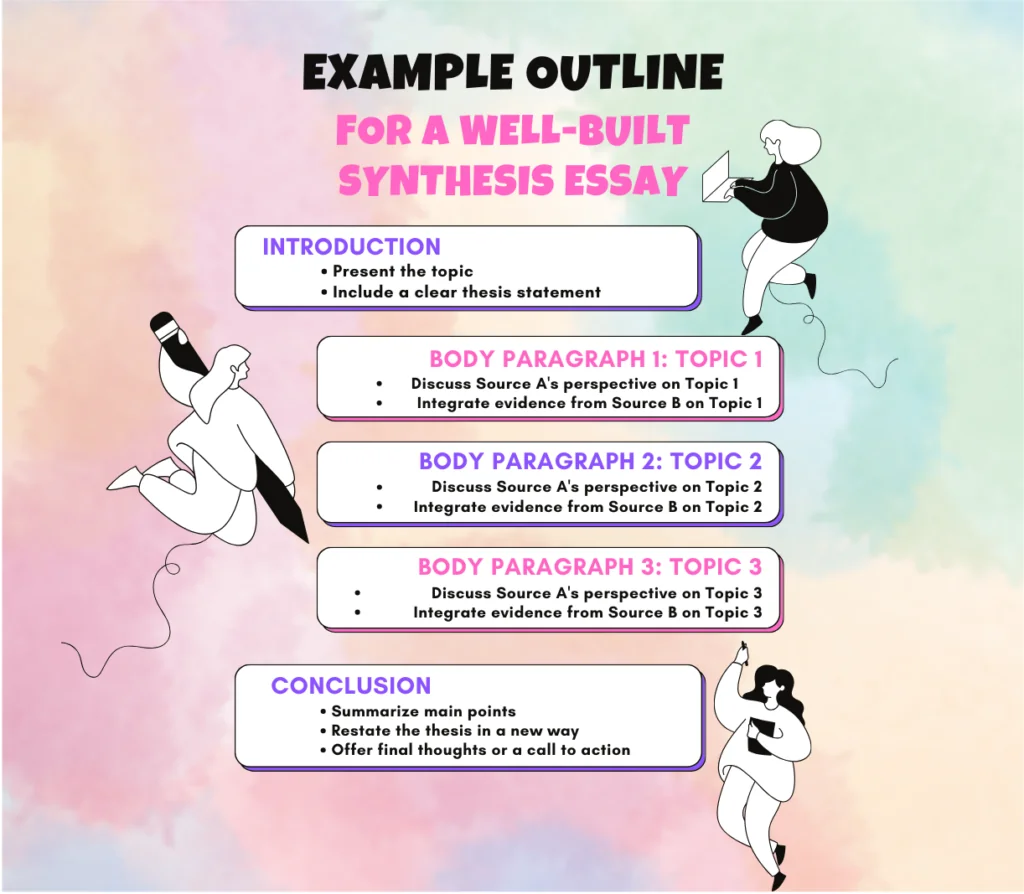Those who are high school or university students, or who were in those ranks before, probably know from first-hand experience what a synthesis essay is. It is one of the most popular tasks among teachers and professors as it shows the students’ abilities to carry out an evidence-based discussion. Nonetheless, the fact that it is widespread doesn’t make the synthesis essay format an easy one. As with any other type of writing, this one requires a knowledge of the proper structure and its components for the essay to be done properly. If you stick around till the end of this article, we promise that you’ll know all the essentials of a well-done synthesis paper.

✅ AI Essay Writer ✅ AI Detector ✅ Plagchecker ✅ Paraphraser
✅ Summarizer ✅ Citation Generator
What is a Synthesis Essay
We acknowledge that you probably have a vision of what is a synthesis essay. Yet, we feel it is important to get the definition clearly and correctly. So, a synthesis essay is a type of writing that involves gathering information from various sources to develop a new idea or argument. Essentially, it combines points, data, and evidence from different places into a single, logical narrative. The central idea of a synthesis essay is represented by the thesis statement, which succinctly explains the main point of the essay. This new idea usually consolidates the main points and findings of the other sources.
One of the defining characteristics of a synthesis essay is its ability to integrate diverse viewpoints. This requires you not to just simply summarize the sources but also put them together to support your thesis. The goal is to create a blanket discussion that is supported by evidence from multiple perspectives. Synthesis essays can be:
- explanatory, aiming to inform the reader,
- or argumentative, focusing on persuading the reader of a particular viewpoint.
Usual Structure for a Well-Written Synthesis Essay
A well-written synthesis essay typically follows a structured format. It begins with an introduction that presents the main topic and includes a clear thesis statement. The body of the essay is divided into several paragraphs, each focusing on a specific point that supports the thesis. Each paragraph integrates information from different sources, with proper citations. Finally, the essay concludes by summarizing the main points and reiterating the thesis in a new way, offering some final thoughts or a call to action.

Forming a Synthesis Essay Thesis
Your thesis statement is the first step toward building a cohesive essay. It represents the central idea that ties together the various sources and perspectives you’ll discuss. To create a strong thesis, start with research. Thoroughly read your sources and understand the main points and arguments they present. Your thesis should concisely answer the question posed by your assignment, summarizing your stance and the reasoning behind it. You can then use an essay summarizer to see if your thesis statement reflects it well.
A good thesis statement for a synthesis essay should include the subject, your position on it, and the significance of your viewpoint. For instance, if your essay topic is about the allocation of tax dollars, your thesis might be:
“Tax dollars should be invested in renewable energy projects because they create jobs, reduce environmental impact, and lead to long-term economic savings.”
This statement clearly outlines the subject (tax dollars), your stance (investment in renewable energy), and the reasoning behind your position.
When writing your thesis, avoid being vague or overly broad. A thesis like “Renewable energy is good” is too general and lacks depth. Instead, focus on specific aspects and provide a clear rationale. Also, avoid a thesis that summarizes your sources without presenting an original idea or argument. Here are a couple more examples of well-written and formulated thesis statements for a synthesis essay:
“Denmark leads the world in renewable energy due to its comprehensive approach to energy conservation, including district heating, combined-heat-and-power stations, and a decentralized power grid system.”
“Implementing universal basic income can reduce poverty and stimulate economic growth by providing financial stability, encouraging entrepreneurship, and increasing consumer spending.”
How to Write a Synthesis Essay Step-by-Step
Okay, so as we got all the basics out of the way and have an idea of how to start a synthesis essay, we can finally move on to writing. It is much easier to divide the process into several parts, as this will help you follow the structure more closely, as well as build a more logical narrative. Here’s a step-by-step guide to help you through the process:
- Choose a Topic
Begin by selecting a topic that interests you and is broad enough to have plenty of research material but specific enough to be manageable. Your topic should allow for the integration of various sources and perspectives. - Conduct Research
Gather information from reliable and relevant sources such as academic journals, books, and reputable websites. Make sure to annotate and take notes on key points, arguments, and evidence that support your thesis. - Formulate a Thesis Statement
Develop a clear and concise thesis statement reflecting the main point of your essay. Your thesis should bring together the ideas from your sources and present your stance on the topic. For instance, “Investing in renewable energy is necessary for economic growth and environmental sustainability.” - Create an Outline
Plan the structure of your essay by outlining the main points and how they will support your thesis. Each body paragraph should focus on a specific aspect of your argument, backed by evidence from your sources.
- Write the Introduction
Start with a hook to grab your reader’s attention, provide some background information on your topic, and end with your thesis. The introduction sets the stage for your essay and prepares the reader for what’s to come. - Draft the Body Paragraphs
Each body paragraph should start with a topic sentence that introduces the main idea of the paragraph. Follow this with evidence from your sources, explaining how it supports your thesis. Don’t forget to analyze and connect the evidence to your argument, vividly presenting similarities and differences between sources. Address counterarguments to strengthen your position. - Conclude Your Essay
Summarize the main points discussed in the body paragraphs with an AI summarizing tool and restate your thesis in a new light. The conclusion should reinforce your argument and leave a lasting impression on the reader, emphasizing the significance of your synthesis. - Proofread and Edit
Review your essay for any grammatical errors, inconsistencies, or unclear points. Your writing should flow logically and your sources have to be correctly cited. A polished essay you can get from a college essay editing service improves your credibility and makes your argument more persuasive.
After everything you’ve done, you can format the document according to the style requirements of your task. Remember, that the time you use in your narrative will depend on the formatting you use: for MLA you should write in the present tense, and for APA – in the past. Those of you who follow all of the mentioned steps will most likely end up with effectively synthesized information creating a well-structured and compelling essay.
Synthesis Paper Topic Ideas
We understand that brainstorming ideas for a synthesis essay can be challenging, so we’re here to help. Whether you’re a high school or university student, having a good subject for a discussion can make all the difference. Here are some possible topic suggestions we have gathered for you:
| Argumentative Topics | Explanatory Topics |
|---|---|
| The impact of social media on teenagers | The benefits and drawbacks of school uniforms |
| Should students have part-time jobs? | The influence of video games on behavior |
| The ethics of artificial intelligence | Effects of extracurricular activities on academic performance |
| Climate change policies and their effectiveness | The role of technology in modern education |
| The implications of genetic engineering | The importance of mental health education in schools |
| The economic effects of immigration | The impact of globalization on local cultures |
| The relationship between diet and health | The future of renewable energy sources |
| The influence of video games on behavior | The role of art and music in education |
FAQ
Follow us on Reddit for more insights and updates.





Comments (0)
Welcome to A*Help comments!
We’re all about debate and discussion at A*Help.
We value the diverse opinions of users, so you may find points of view that you don’t agree with. And that’s cool. However, there are certain things we’re not OK with: attempts to manipulate our data in any way, for example, or the posting of discriminative, offensive, hateful, or disparaging material.